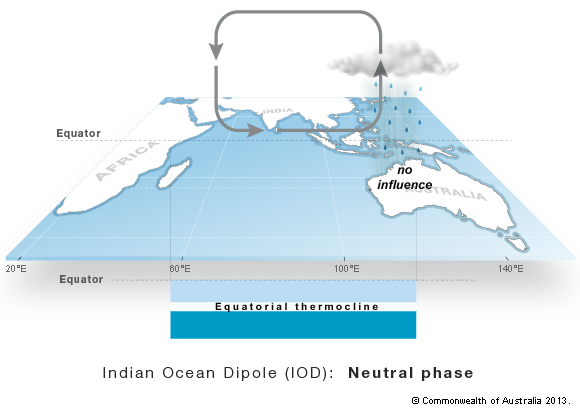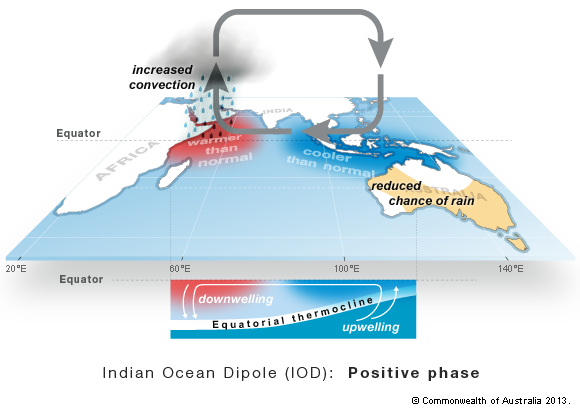Understanding the Indian Ocean Dipole (IOD)
Sea surface temperatures
Indian Ocean sea surface temperatures impact rainfall and temperature patterns over Australia. Warmer than average sea surface temperatures can provide more moisture for frontal systems and lows crossing Australia.
Indian Ocean Dipole
Sustained changes in the difference between sea surface temperatures of the tropical western and eastern Indian Ocean are known as the Indian Ocean Dipole or IOD. The IOD is one of the key drivers of Australia’s climate and can have a significant impact on agriculture. This is because events generally coincide with the winter crop growing season. The IOD has three phases: neutral, positive and negative. Events usually start around May or June, peak between August and October and then rapidly decay when the monsoon arrives in the southern hemisphere around the end of spring.
Neutral IOD phase
Water from the Pacific flows between the islands of Indonesia, keeping seas to Australia’s northwest warm. Air rises above this area and falls over the western half of the Indian Ocean basin, blowing westerly winds along the equator.
Temperatures are close to normal across the tropical Indian Ocean, and hence the neutral IOD results in little change to Australia’s climate.
Positive IOD phase
Westerly winds weaken along the equator allowing warm water to shift towards Africa. Changes in the winds also allow cool water to rise up from the deep ocean in the east. This sets up a temperature difference across the tropical Indian Ocean with cooler than normal water in the east and warmer than normal water in the west.
Generally this means there is less moisture than normal in the atmosphere to the northwest of Australia. This changes the path of weather systems coming from Australia’s west, often resulting in less rainfall and higher than normal temperatures over parts of Australia during winter and spring.
Negative IOD phase
Westerly winds intensify along the equator, allowing warmer waters to concentrate near Australia. This sets up a temperature difference across the tropical Indian Ocean, with warmer than normal water in the east and cooler than normal water in the west.
A negative IOD typically results in above-average winter–spring rainfall over parts of southern Australia as the warmer waters off northwest Australia provide more available moisture to weather systems crossing the country.
IOD-in-Australia
Categories: Definitions, Ocean






